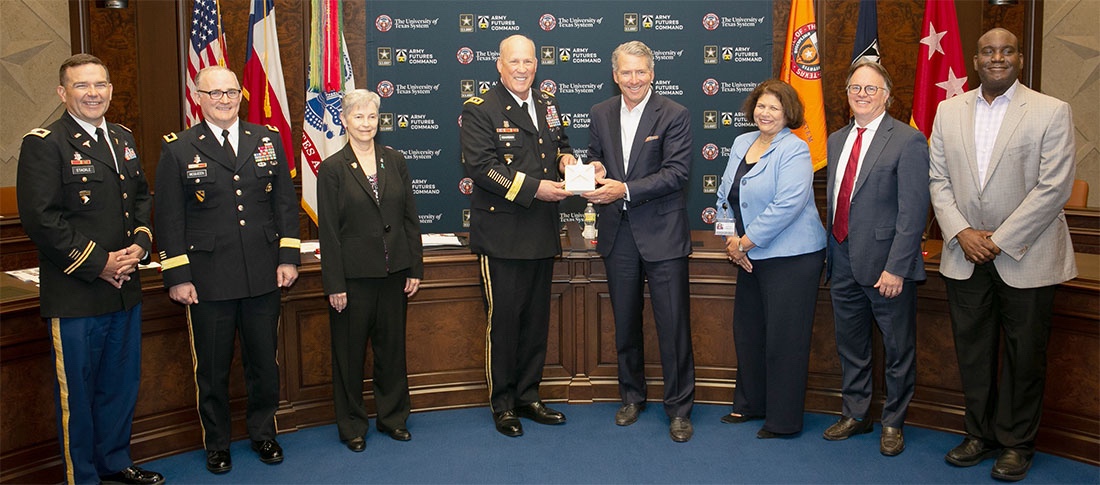The University of Texas System and the United States Army Futures Command (AFC) have formed an official educational and cooperative research partnership to advance medical science and technology to save lives both on and off the battlefield.
Since last year, leaders from the UT System, AFC, U.S. Army Medical Research Command and U.S. Army Institute of Surgical Research (USAISR) have been exploring how to work together to solve some of the most critical issues affecting soldiers injured in combat.
Today, they formally signed two agreements to streamline collaboration between the military and UT institutions: an Educational Partnership Agreement and a Cooperative Research and Development Agreement.
The agreements will allow a continuous flow of resources, research and scientific expertise, focusing specifically on medical science and technological innovations.

“I can not emphasize how groundbreaking this will be,” said Lt. Gen. James Richardson, AFC acting commanding general. “This will allow opportunities for furthering research and expand capabilities for improving our work in the critical area of trauma care, which will extend to our future soldiers and also have impacts in our communities.”
The partnership will leverage the scale and expertise of the both the UT System and the Army, UT System Chancellor James B. Milliken said.
“The military brings to the table a substantial health research infrastructure, unrivaled experience in battlefield trauma, and the capacity to test innovations in the field,” Milliken said. “UT institutions offer an extensive basic and applied science infrastructure, a world-class system for conducting clinical trials, and some of the world’s most brilliant and innovative minds.”
During a Summit last year, researchers and military health specialists from AFC and the UT System emphasized the need to turn the “Golden Hour” into the “Golden Day,” referring to the timeframe following a battlefield wound when proper medical treatment is crucial to survival. Following the Summit, several UT institutions and USAISR developed collaborating research proposals to address the underlying causes of tissue damage and novel treatment options following trauma.
The UT System and Army Futures Command anticipate that the new partnership will have long-lasting impacts on both soldiers as well as civilians who suffer traumatic injuries that land them in the emergency room.
The partnership also builds on numerous existing collaborations between the Army and UT institutions.
The UT System Board of Regents allocated $50 million to UT Austin to establish facilities to develop and test robotic systems and artificial intelligence through the new Robotics Center of Excellence. Researchers at UT Arlington are studying the human dynamics of decision-making, and UT Dallas is creating chemically powered artificial muscles that could power robotic mules to serve as alternative Army vehicles. UT San Antonio and UT El Paso are working with the Army to advance cybersecurity.
In addition, the UT System currently has several research projects with the Department of Defense to create more technologically advanced cybersecurity systems and to support the use of robotics in combat. The collaboration aims to deliver breakthroughs in the science of combat casualty care, such as delivering oxygen to tissue, shock management, wound progression and infection, as well as physical pain or PTSD.


If you want to turn the “Golden Hour” into the “Golden Day” then TRADOC needs to start by training all 68Ws to be Paramedics.
All the cool tech in the world is worthless if it is to be used by medics with zero anatomy, physiology and pharmacology background or if they are pushed through the course through lower and lower standards. Just two years ago there was an effort to do exactly that, I saw the entire presentation. TRADOC shot it down.
The Left hand (TRADOC) and the Right hand (AFC) don’t seem to know what each other are doing.
I largely concur. But even if/when this level of medic training is ever achieved, and all the associated institutional speedbumps are sorted out (enlistment / pipeline/ tour length disconnects; a generation of E-2 thru -4 medics who “outskill” much of their leadership; what to do with training failures?; etc), there remains the huge problem of skill sustainment.
75% of Army medics are in MTOE units, not in hospitals or other clinical settings. Aside from a precious few rotational opportunities, most medics will go an entire enlistment, even most of a career, with little meaningful, concentrated patient care immersion. Those expensive and hard-won skills degrade very very quickly for the average medic, who is more likely PMCS-ing an ambulance down in the motor pool.
Solution? Maybe put every enlisted-heavy medical unit on annual rotation to some Third-World $#!^ hole, like Sierra Leone, Chicago, Liberia, or New Orleans, just to get plenty of current experience with trauma and gunshot wounds.
What ever happened to the grand idea of having all the military medics be “emergency medical technicians-tactical”? Must have got bogged down and forgotten by the NREMT and the DoD. Army medics really don’t need the civilian paramedic level of training. They can already do most of the important interventions that paramedics do; advanced airways, IV therapy and limited pharmacology. Does a combat medic really need the cardiology/ACLS component? I don’t think so. What they need is some more A&P in the school house and standardized medical SOP’s through out the army. Every unit I was assigned too had different medical SOP’s, really depended on what the BN Surgeon would let us do.
Get the medics out of the motor pool and rotate them through the TMC’s, the ED’s of the local military and civilian hospitals and with local 911 ambulances. Give them “real world” practical experience.